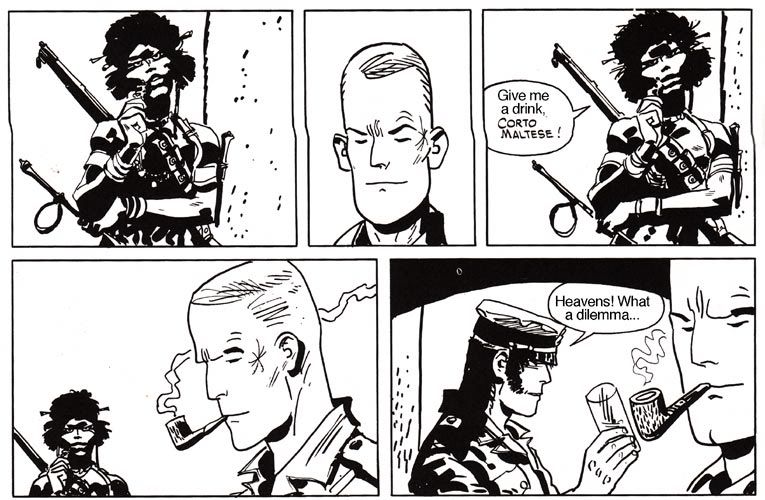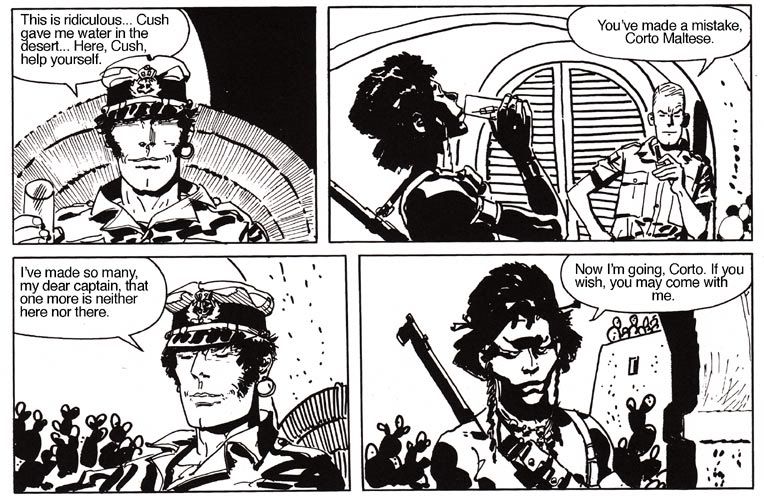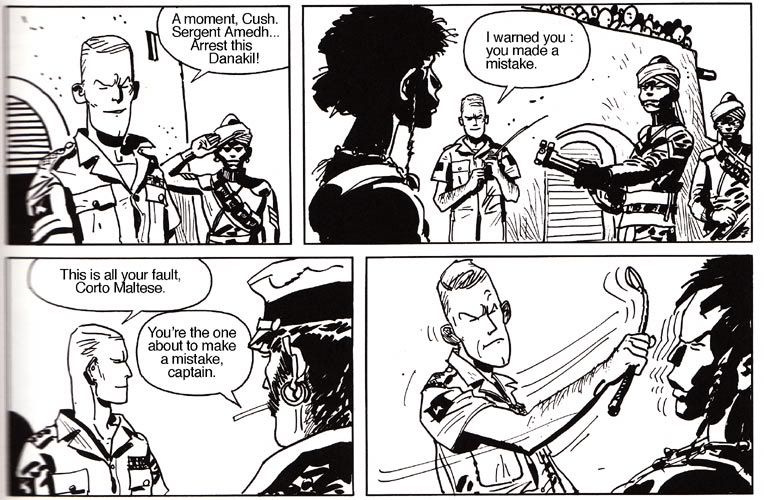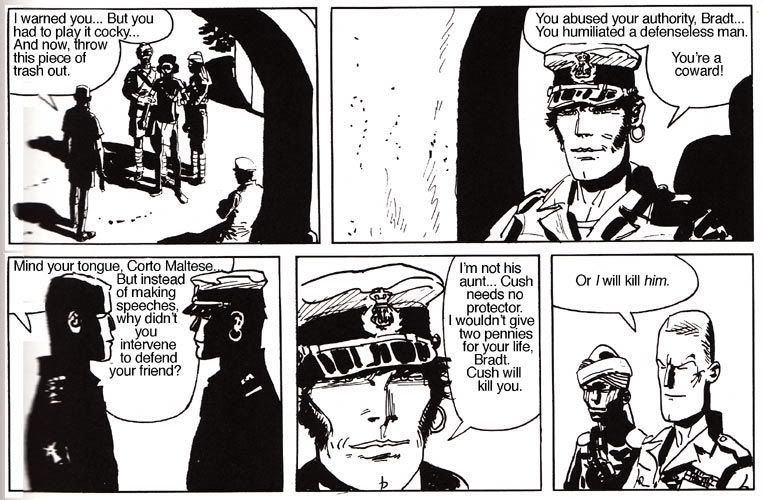|
|
Post by berkley on Jul 12, 2016 0:23:53 GMT -5
I'd really like to see Marini do something with a female lead because I almost always find his heroines and villainesses more interesting than his male characters, Gipsy being a case in point. I haven't read Scorpion, though, that one sounds more interesting.
|
|
|
|
Post by foxley on Jul 12, 2016 0:29:13 GMT -5
I'd really like to see Marini do something with a female lead because I almost always find his heroines and villainesses more interesting than his male characters, Gipsy being a case in point. I haven't read Scorpion, though, that one sounds more interesting. One of the most interesting characters in Le Scorpion is Mejai, a female gypsy assassin. |
|
|
|
Post by berkley on Jul 12, 2016 20:04:41 GMT -5
I'd really like to see Marini do something with a female lead because I almost always find his heroines and villainesses more interesting than his male characters, Gipsy being a case in point. I haven't read Scorpion, though, that one sounds more interesting. One of the most interesting characters in Le Scorpion is Mejai, a female gypsy assassin. And the most intriguing character for me in Gipsy was the title character's antagonist, a female assassin of Middle Eastern origin; in contrast to the male lead, who was a more or less generic big, good-looking macho guy, Conan as a truck driver. |
|
|
|
Post by foxley on Jul 12, 2016 23:42:44 GMT -5
One of the most interesting characters in Le Scorpion is Mejai, a female gypsy assassin. And the most intriguing character for me in Gipsy was the title character's antagonist, a female assassin of Middle Eastern origin; in contrast to the male lead, who was a more or less generic big, good-looking macho guy, Conan as a truck driver. Maybe I should look more closely at Gipsy then. The cartoony art and the sci-fi setting have tended to pit me off. |
|
|
|
Post by berkley on Jul 14, 2016 1:15:58 GMT -5
And the most intriguing character for me in Gipsy was the title character's antagonist, a female assassin of Middle Eastern origin; in contrast to the male lead, who was a more or less generic big, good-looking macho guy, Conan as a truck driver. Maybe I should look more closely at Gipsy then. The cartoony art and the sci-fi setting have tended to pit me off. The science fiction element is pretty subdued, AFAIR - near future scenario, I think the technology isn't much different from today's. The changes are mostly political - and I think there's a highway that runs continuously around the globe, which is why the truckers are important ... I can't recall much about it, to be honest. |
|
|
|
Post by berkley on Aug 21, 2016 22:15:34 GMT -5
Not sure if this really qualifies as a European comic - I believe the writer is Spanish and the artist Mexican - but anyway, I came across a review of a book called Pancho Villa: La Bataille de Zacatecas the other day and thought it sounded good. I did an image search to get an idea of the artwork and liked what I saw:   Unfortunately, it seems to be very expensive for some reason so I probably won't buy it unless and until I see it somewhere at a more reasonable price. |
|
|
|
Post by hondobrode on Aug 21, 2016 22:30:57 GMT -5
I've never bought a non-English book or a foreign book that wasn't translated to English, even any of the Moebius, Druillet, Manara, etc.
|
|
|
|
Post by berkley on Aug 22, 2016 0:40:06 GMT -5
I did see an English version of that Pancho Villa book but only in kindle format, which I'm not really into.
|
|
shaxper
CCF Site Custodian
Posts: 22,871
|
Post by shaxper on Aug 22, 2016 5:08:49 GMT -5
Not sure if this really qualifies as a European comic - I believe the writer is Spanish and the artist Mexican - but anyway, I came across a review of a book called Pancho Villa: La Bataille de Zacatecas the other day and thought it sounded good. I did an image search to get an idea of the artwork and liked what I saw:   Unfortunately, it seems to be very expensive for some reason so I probably won't buy it unless and until I see it somewhere at a more reasonable price. Is he using woodcuts?? |
|
|
|
Post by berkley on Aug 22, 2016 11:41:08 GMT -5
Not sure if this really qualifies as a European comic - I believe the writer is Spanish and the artist Mexican - but anyway, I came across a review of a book called Pancho Villa: La Bataille de Zacatecas the other day and thought it sounded good. I did an image search to get an idea of the artwork and liked what I saw: Unfortunately, it seems to be very expensive for some reason so I probably won't buy it unless and until I see it somewhere at a more reasonable price. Is he using woodcuts?? It sure looks like it, doesn't it. I haven't read up on it to confirm, though. |
|
shaxper
CCF Site Custodian
Posts: 22,871
|
Post by shaxper on Aug 22, 2016 21:36:35 GMT -5
Corto Maltese: The Ethiopian arrived in the mail today. Might wait until March's Read A Graphic Novel Week to dive into this one.
|
|
|
|
Post by Dizzy D on Aug 23, 2016 6:06:02 GMT -5
Bought a few issues of The Elves (Simply Elfes in the original language). I bought an issue before and it has an interesting system to do a comic series: at first I thought it was a series of standalones in a fantasy universe with each issue a new creative team, but there are ongoing story-arcs: issues 1-6-11 and so on is one storyline with one creative team, 2-7-12 is another storyline and creative team, 3-8, 4-9 and 5-10 are the other storylines so far. Each storyline focuses on a different species of Elves that all live in the same world. Had a few random issues of the series and so far, the 1/6/11 storyline (Focusing on the Blue Elves) and issue 5 (Dark Elves) were promising. I didn't like issue 3 (White Elves). It's standard high fantasy so far, so it hinges mostly on the artwork, but I like the way to do this series with different teams so you can have a decent pace of issues coming out compared to most European series while still having a high quality.
Also bought a few issues of Le Chante des Stryges (translated into dutch as Song of the Vampires), because they were cheap and I never read the series before. Not really impressed with the artwork or the writing, but I do like that these vampires have a quite different design from usual, their design being inspired by vultures rather than bats. (While writing it and doing a bit of research, I see now why. Strixes have been translated as vampires in the dutch comic, but they are other mythological creatures from Greek and Roman mythology, based on owls (so not vultures), that feed on the flesh and blood of their victims. I thought the name came from the Romanian Strigoi that are more like traditional vampires, but those turned out to be based on the Greek Strix. Anyway happy to see some lesser used mythological creatures for a change.)
Also still writing up a bit on Lanfeust of Troy and I have a few days off, so maybe I'll finally put something down that I won't delete once I have reread it.
|
|
|
|
Post by Roquefort Raider on Aug 23, 2016 8:09:09 GMT -5
Corto Maltese: The Ethiopian arrived in the mail today. Might wait until March's Read A Graphic Novel Week to dive into this one. That's an awesome Corto Maltese arc. Hemingway-level in my opinion. And Cush is one of the coolest characters ever created!!!       |
|
|
|
Post by Dizzy D on Aug 23, 2016 10:01:17 GMT -5
Eh, still not happy with it, but here it is:
Lanfeust of Troy (or rather Lanfeust).
Written by Christophe Arleston and drawn by Didier Tarquin (and interesting: this series list writer first and artist second unlike most European comics).
Christophe Arleston has made a nice career out of the world of Troy (more on that later), a fantasy setting with sci-fi elements, but he's also known for the series Ythaq, a sci-fi series with fantasy elements. This man has range! Joking aside, he's done works in other settings; Lord of Burger and Leo Loden are contemporary, Tandori seems to be set in late 19th/early 20th Century British India and Mycroft Inquisitor seems to be about Sherlock Holmes' brother (don't know sure about the last ones, they have not been translated over here. But the vast majority of his works are sci-fi/fantasy stories).
Tarquin meanwhile seems to do only sci-fi/fantasy with few steps outside of the Troy universe, but if you put the first and more recent issues next to each other, you can see a world of difference in his style. The first issues are very rough, but between issue 6 and 7 of Lanfeust of Troy a major difference in style can be seen, going for a more exaggerated cartoonish style vs. the rough but more realistic style from before. He also starts to add little injokes in the background of many scenes (check the faces of various aliens in the background in Lanfeust of the Stars, you might recognize some of them).
Lanfeust of Troy/the Troy-verse or whatever name we're going to give to the whole continuum of books started in 1994 with the series Lanfeust de Troy, an 8 issue series which would be chapter 1 of several series focusing on main character Lanfeust and the magical world of Troy. It would have 2 sequels so far: Lanfeust d'Etoiles (Lanfeust of the Stars, also 8 issues) and Lanfeust Odyssey (you can work that one out. Odyssey is still running as we speak, on issue 7 right now and the series usually have 8 issues, so probably 1 coming.). And then we're only getting started. Cixi de Troy is a 3 issue series that focuses on supporting character Cixi during the events of Lanfeust de Troy. Then we have spin-off Trolls of Troy (Trolls is at 18 issues according to Wikipedia, but it seems the article hasn't been updated in ages because they are at 5 issues for Odyssey, while I have issue 7 right here in dutch translation, so probably more) and the more comedic Gnomes de Troy. And not to forget Conquerors of Troy, Legends of Troy (both taking place a long time before the first series), Lanfeust Quest (a manga-style adaption of the main series) and probably many more. You get the idea: the series has been quite a success and I even saw a cartoon adaption on TV not so long ago (which is a bit weird as the series has multiple adult elements, but then again we got cartoons of Rambo, Robocop, Conan and many more, didn't we?). Anyway, I only read the main series (which has been translated into English, so you can pick it up), while occassionally picking up a spin-off if it looks interesting. So this bit will only be about the main series.
DISCLAIMER: Way back on CBR when the series was first released in english, somebody complained that the series didn't take place in the historical/mythological city of Troy and that this was (and I literally quote here) “false advertising”. To this gentleman (or possible lady), I'd like to point out the following: the series is called Lanfeust de Troy in french, its original language. The historical city's name in french is spelled Troie (and pronounced differently). The name Troy has a reason in french, but explaining that would get us into spoiler-territory. They could have changed the name for the translation to prevent confusion, but really why bother? So in short the Troy in this series is a planet, nothing to do with the ancient city, not even named after it. END OF ANNOYED DISCLAIMER.
The setting:
Troy is a magical world and most of his human inhabitants each have a single unique magic power (or at least unique for as far as we can determine), ranging from the useful to the useless (though as I like to note when it comes to so-called useless powers, with a bit of brains most useless powers usually have their advantages). There are limitations though, the powers only work when a Sage is present. A Sage is a human who has given up his own power and been trained in mystical studies to channel mystical power into the humans around him. Sages seem to have a range of a mile or so, so you usually have a single Sage per village and multiple Sages per town). Out in the wilderness, usually Sages aren't present, so you don't have your powers to count on (if there were any good to begin with). More on the specifics behind this system is explained within the first series as the main characters discover more about the magical powers and their source. These magical powers are pretty necessary as Troy is a dangerous world and its primary danger are the Trolls: big, incredible strong and cannibalistic, they have no moral problems with killing and then even eating humans if they feel like it. The biggest problem: they are not stupid, they can be savage, but most of them are quite clever. Luckily the Sages also know methods to hypnotize Trolls to tame them, but it really only makes them not as savage and forced to obey commands (to the letter, not to the spirit and many trolls are capable of rules-lawyering the way out of commands they don't like, the source of quite a bit of humor in the series. A scene in the first series for instance has one of the villains orders two Trolls to split up, canvas the area and find the hero. One of the Trolls notes to the other that it would be smarter if they just both went in the same direction, because they both saw the direction the hero went, but orders are orders and they don't really like their boss, so whatever, they split up and canvas the area).
The plot in short:
In Lanfeust of Troy, Lanfeust, a young man with the power to melt metal (useful as he has chosen to be a blacksmith) is ordered by a travelling nobleman (the knight of Gold-Azure (Or-Azur)) to repair his sword. When touching the sword, Lanfeust true power is awoken: as long as he touches the specific sword he can use any power any of the people on Troy have). The local Sage, his daughters C'ian (incidentally also Lanfeust fiance, who has the power to heal people, but only at night) and Cixi (who is more egoistic compared to her sister and forces the others to take her so she can get to see the big city) decide to take the sword to the Sage academy in the capitol with Lanfeust and the (protesting) knight of Gold-Azure along. On their way to the capitol the Sage hypnotizes Hebus, one of the trolls that attacks them and he joins the company. They also discover that somebody else has the same ability as Lanfeust, the pirate Thanos (no relation to a certain purple-skinned Titan) and a battle for the sword takes place.
In Lanfeust of the Stars, it turns out that Troy is one of many planets colonized by humans, but the colony has fallen into barbarism in the past. A spaceship with researchers lands on Troy and takes several of the characters from the first series along to study Lanfeust's ability. Little can be said without spoiling some major plotpoints of the first series. Well Hebus goes along, as he's pretty much the most popular character of the series.
In Lanfeust Oddysey, Lanfeust and Hebus return to Troy, years after they have left. Lanfeust hasn't aged much due to events in Lanfeust of the Stars, so he has to deal with changes in the world while he left.
Overall, the tone of Arleston/Tarquin's work is rather unique in my experience. The style is cartoony (even more so as the series progresses), but there are various adult elements and the tone swings to ratyher casual hyper-violence; Hebus happily kills any obstacle in his way in gruesome manners and the rest of the group seems to have little to no problems with it. In return Hebus being forced to obey the rest would lead to tension in any other title, but when the spell is broken, Hebus follows along, saying that he rather likes these people and in turn Lanfeust and friends risk their lives at various points to protect Hebus.
The (nominal) heroes all have their flaws, but the more flawed among them also have their good sides; the knight of Gold-Azure, for instance, even when usually treated as a joke compared to Lanfeust and Hebus when it comes to combat, has his own moments of heroism. The constant switching between comedy and serious moments may be annoying to some readers, but I really like it. There is a scene where Lanfeust and his party are hit by neural disrupters that reduces their intelligence. The same device has a the reverse effect on the chicken and goat that travel with them and those two immediately take it upon them to defend the party by grabbing a sword and stick. The same goat and chicken stick around for several issues afterwards, while at the same time named characters die, are enslaved or betray their friends.
A thing that does annoy me a bit, especially in Oddysey is how some characters just drop out of the story (and for that matter how much of the storyline is planned in advance, both in Stars and in Oddysey you can get the impression that Arlestone is making it up as he goes along).
|
|
|
|
Post by Dizzy D on Oct 11, 2016 13:08:40 GMT -5
So I've discovered that a year or 2 ago, Henk Kuijpers revisited and rereleased a lot of his earlier Franka issues (to be precise issue 8-15 as far as I can tell), but did a George Lucas special edition of each with some rearranged panels, new colouring, but most important some extra pages. (Franka was released 1 page a week at the time in a TV guide which limited what he could do on the pages). I found out when the latest issue referred to events that only happened in a rereleased edition. So choices, choices, am I going to rebuy 8 issues at $10 each for 4-8 extra pages... dammit, I think I am. So far I've 3, some are improved (some characters are more fleshed out, some scenes more detailed, long blocks of text spread out over various panels), some are not (panels enlarged to fit the new page, which doesn't really work). Occassionally you see the panels that were clearly just put there so he could turn them into a poster later. The epilogue to "The 13th letter" doesn't really work for me, because it's too revisionist, epilogue to #15 did work as it filled in the timespan between #15 and #16 a bit better.) Anyway, not what I wanted to talk about. There is a thread called if we ever bought a comic based on the cover. This one is coming out tomorrow and I'll be buying it based on its cover with no knowledge of neither writer nor artist.  |
|